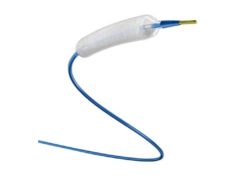
Data from the LOCOMOTIVE registry first-in-man trial investigating the VascuFlex Multi-Loc, B Braun’s multiple stent delivery system, were presented by Klaus Amendt (Diakonissenkrankenhaus, Mannheim, Germany) at the Leipzig Interventional Course (LINC; 30 January–2 February 2018, Leipzig, Germany). The data followed promising six-month results presented by Amendt the previous year at the Charing Cross Symposium (25–28 April 2017, London, UK), and continued to show high patency rates and freedom from target lesion revascularisation (TLR).
The LOCOMOTIVE study is a first-in-man, non-randomised, prospective and multicentre trial conducted at facilities in Germany and Switzerland. Its objective is to assess the safety and efficacy of VascuFlex Multi-LOC, a device using multiple stent delivery system (MSDS) to treat long femoropopliteal lesions with focal stenting. With a total cohort of 75 patients (mean age 72.9±9.2 years), LOCOMOTIVE is an all-comers registry and no patients were excluded, although exclusion criteria included in-stent restenosis and restenosis following drug-coated balloon (DCB) angioplasty. The primary endpoint was defined as TLR rate.
MSDS, or spot stenting, is a strategy employed by the VascuFlex Multi-LOC system to deliver up to six short (13mm) self-expanding nitinol stents as needed in complex peripheral lesions. In the LOCOMOTIVE study, stenting was predominantly (75%, n=75) preceded by plaque preparation using percutaneous balloon angioplasty (PTA).
At six months, the MSDS device had achieved primary patency of 90.7% and a 94.7% freedom from TLR. Speaking at LINC this year, Amendt commented that the data at 12 months was “quite convincing”, adding later that the successful results were owed to plaque preparation with PTA. The updated study results demonstrated primary patency in 85% of all patients, assisted primary patency at 96.8% in all patients and 100% in the critical limb ischaemia patient group. Overall TLR rose from 5.3% to 9.3%, although no additional TLR was seen in the critical limb ischaemia group.
Comparing the current data with the earlier six-month results, Amendt observed, “There is still a benefit in the ankle–brachial pressure index (ABI) and the Rutherford classes, we had no further amputations, and we had three more deaths in [the non-critical limb ischaemia patient group]”. Target leg ABI at 12 months was 0.91 (±0.38, p=0.973), and a shift in Rutherford classification by 2.2 (±1.3, p=0.038) classes as compared to pre-procedure was observed.
Amendt concluded that the 12-month data demonstrate the safety and efficacy of MSDS in patients with peripheral arterial occlusive disease Rutherford class 2–5 and femoropoplietal lesions. “We had a high procedural success at 100%, we did not lose any stents and left no movement in the stents after 12 months”, he added. “Nearly half of the lesion length could be kept free from stents, and TLR and patency rates are still promising after 12 months.”
Speaking to Vascular News last year, Amendt considered next steps, commenting, “We think that the combination of a drug-eluting balloon (DEB) and this decided stenting only of short lesions is the concept of the future. Because it is a relatively hard stent with a high outward force to keep even the calcified tissue open. The next step will be a randomised study with DEB and Multi-Loc.”












